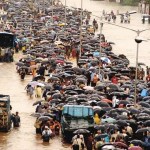Context
Over 50% of all people on the planet now live in cities, or urban environments, and by 2050 there will be 70% living in cities. We will indeed be a world of cities, and any impacts from climate change will reverberate throughout these cities. Much of the growth will occur in developing countries and the United Nations has taken a proactive role in addressing the implications of the growth.
In particular, the United Nations Human Settlements Programme, known as UN-Habitat, has published a series of reports on Water and Sanitation in the World’s Cities. In preparation for their fourth global report, the UN-Habitat commissioned the PBL Netherlands Environmental Assessment Agency (PBL) to undertake a study on future trends and challenges with regard to water supply and sanitation; nutrients in surface water; and, flood risks. The PBL study relied on its own sophisticated modelling capabilities and existing risk assessment scenarios from the Organisation for Economic Co-operation and Development (OECD) and others.
What kind of world can we expect by 2050
The world’s population will grow from 7 billion in 2010 to 9.2 billion by 2050, and in the 49 least developed countries the population will double in size. Much of the growth will be seen in cities with current populations of less than 500,000 in developing countries.
Energy demand will be 80% higher in 2050 than it is today, and, disturbingly, fossil fuels are expected to retain a large market share of 85%. Agricultural land will expand over the next decade, because of food demand, peak by 2030, and then decline as population growth slows and yields improve.
With economies of scale, as well as increased use of diminishing physical capital (including natural resources), we will see higher levels of economic prosperity, and the world’s gross domestic product (GDP) will quadruple between 2010 and 2050. The more concentrated, more dense areas of settlement will make it more cost efficient to supply larger numbers of people with access to water and to improve efficiency of energy and land use, especially in comparison to providing such services to a comparable population spread over a wide geographic region.
Global water demand likely will rise by 55% between 2000 and 2050, especially in emerging economies, and over 40% of the world’s population will live in river basins under severe water stress. Irrigation for agriculture currently accounts for 70% of total freshwater demand, and water claims between urban and farming communities will stiffen.
The increased energy demand and continued over-reliance on fossil fuels will lead to atmospheric concentrations of greenhouse gases (GHGs) reaching 685 ppm CO2 equivalents. By 2100, global average temperatures are expected to rise 3°C to 6°C (5.4 to 10.8°F) above pre-industrial levels. Climate change is likely to exacerbate the frequency and intensity of both rainfall and droughts, and extreme weather events, all of which will have significant impacts on large city populations.
This scenario, for life in 2050, especially in cities, served as the basis for the PBL assessment of the various issues
Water Supply and Sanitation
Access to water supplies has improved over the past several decades, and is projected to get better. But there are still major shortfalls in providing access to safe water supplies, and basic sanitation remains elusive for many. For example, in 2011, 800 million people had no access to improved drinking water sources while 2.5 billion lacked access to improved sanitation. The two conditions accounted for 1.8 million deaths in 2004, mostly in Africa and Southeast Asia. Worse yet, 80% of these deaths were children under 5 years of age, an always vulnerable population.
The report covers three levels of water and sanitation services: no coverage; improved services (such as public standpipes or boreholes); and, household connection. It is noted that having a connection does not necessarily ensure access to safe water.
Adding higher levels of protection to water and sanitation provides significant health benefits, with benefit-to-cost ratios as high as 7 to 1 in developing countries. With such improvements, child mortality from diarrhea will drop from 2 million annual deaths in 2000 to 500,000 in 2050. The increase in urbanisation will make it easier and cheaper to deliver improved services, and greater economic growth will help fund these services. A serious qualification to the good news is that the density of cities can lead to slums where many of the gains are lost.
Nutrients in Surface Water
With greater access to water supplies, there is a greater need to treat all the wastewater generated that, without collection and treatment, discharges to surface waters. The discharges are filled with nutrients, particularly nitrogen and phosphorus, which impair the quality of the receiving waters. The results are well-known: eutrophication, biodiversity loss, and polluted drinking water sources.
Primary treatments remove more nitrogen and phosphorus by 10%, and tertiary treatments by 80-90%, and rising GDP will help fund wastewater improvements. Nevertheless, by 2050, while most developed countries will rely on tertiary treatment (required in the EU), most developing countries will have no treatment and some will have only primary or secondary systems.
As an example, the report notes that the city of Accra in Ghana has a population of 4 million people and only about 5-10% are connected to a central sewage system. Instead, faecal sludge is collected from private and public toilets or latrines and septic tanks and dumped on beaches near the city centre every day. By 2050, the population of Accra will be between 8 and 16 million. The sewage problems, and level of nutrients, will increase proportionally.
Rising GDP will also increase risks to surface waters in part due to diets richer in meat and milk that carry more nitrogen emissions, as well as to more dishwasher and laundry equipment and supplies that carry more phosphorus emissions.
Some innovative wastewater systems are being tried including employing shared toilets in slum areas with daily collection of waste and treatment at a central facility to make compost used in agriculture. In the Netherlands and elsewhere, there are new technologies and incentives for reusing nutrients for local agriculture and gardens where large scale projects are too costly.
Flood Risks
Cities tend to be developed adjacent to or near large bodies of water — rivers, bays, lakes, oceans — so the water can be used for commercial and industrial operations, as well as for individuals, and for transportation. With higher concentration of populations near large surface waters, more people will be at risk from flooding in urban areas. Currently there are about 468 cities with populations in excess of 500,000, and in 2050 that number will increase to 670 cities, 88 of which will have more than 5 million.
The PBL assessment of flooding risks does not account for climate change effects as the authors state that at this point the drivers of flood risks are population growth, especially in cities, and economic development, which puts more valuable economic assets in harm’s way. The global annual exposed GDP was $19 billion in 2010, and will rise to $62 billion by 2050. More studies are underway to account for climate change impacts on risk from flooding in 2050 and beyond, when the impacts will deepen and widen.
About 1 billion people currently live in flood-prone areas, and in 2050 it is expected that there will be 1.3 billion. While the difference does not appear dramatic, the report points out that fewer people in rural areas will be exposed in 2050 (fewer people there) while many more in cities will be exposed.
A critical dimension to defining the extent of the risk from flooding in 2050, and the costs, is the level of risk that is acceptable. In poorer areas of limited resources or attention to flooding, the level used is often the risk of a flood that occurs every 10 years (1:100), whereas areas that have some resources and have experienced significant flooding use a risk of a flood that occurs every 100 years (New York) or 200 years (New Orleans. In significant contrast, the city of London along the Thames Estuary uses a protection level of 1:1,000 years, and the Netherlands uses a range of from 1:1,250 to 1:10,000 years.
The report applies the various levels of risk, generally selecting 1:100 for rural areas and 1:1,000 for urban areas, and GDP per capita to estimate the costs of protection against flooding events. The PBL concludes that the economic costs are not insurmountable. For example, the Netherlands, with perhaps the highest standards for flood risks, spent $2-$2.7 billion a year (2013) for the total construction and maintenance costs of flood protection, which represents about 0.3% of GDP.
The fixes for preventing flooding, or minimizing impacts, are generally available and include structural or hard fixes, such as levees, dams, storm barriers, and shelters, and non-structural or soft fixes, such as warning systems, disaster and evacuation plans, risk communication, and spatial planning.
Complicating the solutions, especially for rapidly expanding cities in developing countries, are several factors. First, flood risks are unevenly distributed evenly within cities as poorer areas, particularly slums, are often located in the most flood-prone areas, they are more dense, and people live in sub-standard housing with inadequate health and emergency services, and poorer communication facilities. Second, while flood protection measures are not usually a heavy burden on GDP, developing countries lack the necessary budgets and financing mechanisms, and developing flood risk strategies involves complex institutional arrangements with a long-time delay in seeing the benefits of the expenditures.
Another complication in implementing remedies is that a more affluent upstream community may have the resources to build protective structures that in effect put downstream, perhaps poorer, communities at greater risk. And this scenario also applies across regions or countries where protection in one region or country puts neighbors at greater risk.
Finally, the PBL study looks at the issue of insurance coverage and points out the many difficulties in providing or relying on private insurance to help cities with large poor populations.
Conclusion
A central tenet of the PBL report is that the growth of cities in this century is a dilemma. The concentration of population and increased wealth opens the possibility of cost-effective delivery and funding of water and sanitation services, reduction of nutrient discharges and flood protection. At the same time those people and their increased well-being will add more discharges, and more polluting discharges, to the water and sanitation systems.
Sources
Ligtvoet W. et al. (2014), Towards a world of cities in 2050 – an outlook on water-related challenges. Background report to the UN-Habitat Global Report, The Hague: PBL Netherlands Environmental Assessment Agency.





No comments yet, add your own below